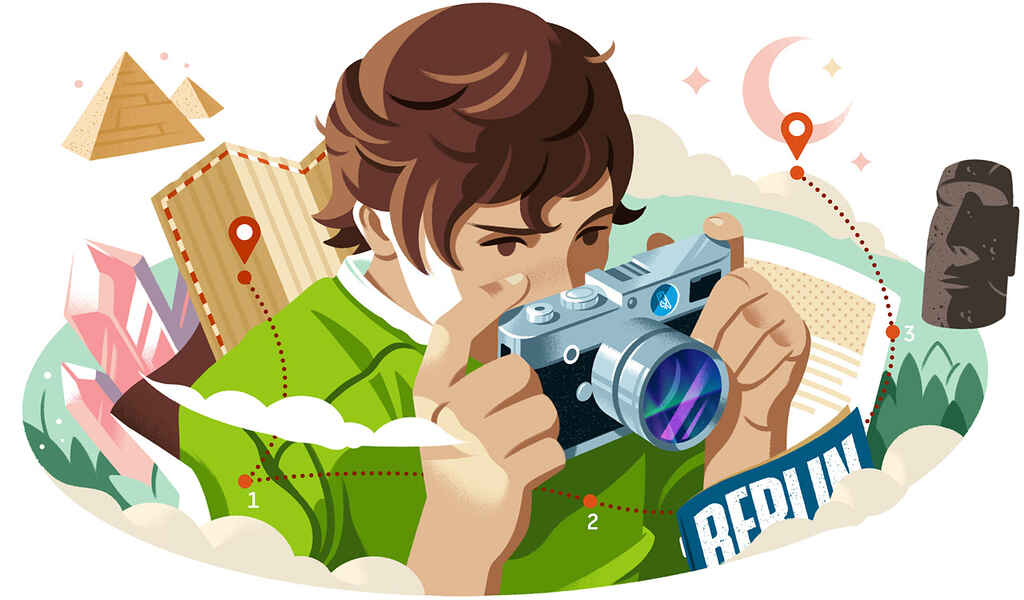Last updated on Jul 12, 2023
How to Become a Travel Writer in 5 Steps: A Guide for Travel Bugs
About the author
Reedsy's editorial team is a diverse group of industry experts devoted to helping authors write and publish beautiful books.
More about the Reedsy Editorial Team →For most people, trekking through the mountains or sampling French cuisine is a rare treat. For travel writers, it might just be another day on the job. As their job title suggests, travel writers create content about anything and everything related to exploring the world.
Whether they’re writing to help readers plan a trip or to transport them — through words — to places they may never visit, no two travel writers share the same journey through their careers. But if you intend to walk down this road and become a travel writer, here are five steps to help you on your professional adventure.
Learn to be a descriptive writer and a thorough researcher
If there’s a single skill-set that almost all great travel writers share, it would be in research and descriptive writing. While people in this profession often have degrees in English or journalism, this is not a strict requirement. People come to travel writing from all walks of life, and publications tend to be concerned with your ability to deliver a great piece over any advanced degree.
Although there isn’t any specific travel writing degree, if you want to learn all you can in one centralized place, there are many travel writing courses that train everyone from experienced journalists to new writers.
Immerse readers with your descriptive writing

Readers want you to take them on a journey with you. If you can’t pay for them to join you on a sea voyage to the Azores, you’ll have to settle for evoking the five senses and other descriptive writing techniques.
Take for example, Paul Theroux. A prolific travel writer with a career spanning five decades, he’s treasured for his ability to pull readers into his adventures with simple yet evocative language, as he does in his essay, “Taking the Great American Roadtrip”:
What made Barstow's billboards a peculiar blight was the contrast with everything that lay around them—the landscape that was so stark and dramatic as a brooding expanse of withered shrubs and fat cactuses, the stony roads that seemed to lead nowhere, the bleak and beautiful backdrop that seemed as though no one had laid a hand on it, with lively colorations at a distance and up close so dry, like a valley of bones looking as though they could not support life. I had seen deserts in Patagonia and Turkmenistan, northern Kenya and Xinjiang in western China; but I had never seen anything like this. The revelation of the Mojave Desert was (peering past the billboards) not just its illusion of emptiness but its assertive power of exclusion, the low bald hills and far-off mountains looking toasted and forbidding under the darkening sky.
Theroux invites the reader on the road with him and describes the desert landscape in crisp detail. The use of simile (“like a valley of bones”) and strong language (“stark, dramatic”) brings the piece to life and gives us a view from Theroux’s window so it feels like we’re traveling along with him.
How do you remember and keep track of all these details while you’re on the go? Keeping a journal while you’re traveling — even if it’s just to another part of the town you live in — is a great method to have all the information you need to write your story when you finally get to sit down and reflect on your journey.
Cherry-pick the details that will tell the best story
Though you may have recorded many interesting details, you can’t include everything. Travel writing may feature a lot of exposition to set the scene, but it isn’t the same thing as keeping a journal. To make a stronger piece, you need to focus on the right stories and details, which means knowing what to add and what you can leave out.
At the same time, being concise is important. Unless you’re running your own blog or website, most digital or physical publications will have word limits to adhere to. Identifying what’s most important and most interesting to your audience as you write makes for more compelling writing.
Preparation is key
For travel writers, research skills go hand-in-hand with writing skills. You might be asked to write about a topic you aren’t familiar with or you might need to learn more about a place’s history or background to give your piece greater context. Research will allow you to create an accurate and well-informed story and help fill in the gaps in your own knowledge. And who knows, you might stumble on something that will inspire your next trip or story.
Before you begin planning your next trip to the most popular destination of the year, you need to research where everyone has already gone. If you find a lot of articles about solo travel in Brazil, that might mean you need to find a new angle or pick a different place entirely, and down another research rabbit hole you’ll go.

Learning as much as you can about the culture and history of the place you’re visiting will undoubtedly deepen your understanding and experience of it. A monument or a park might be pretty and fun to hang out in, but knowing that New York City’s Washington Square Park was built over the graves of 20,000 people makes for both an interesting angle and a more emotionally impactful piece.
Even if you want to write from the perspective of someone going into an experience blind, you still need to do research to travel anywhere — or you’ll end up writing a travelog where you barely find your way out of the airport parking lot.
While these are the main two skills you should focus on, there are a few more that can give you and your writing a boost.
Interviewing
A subset of research, learning how to interview effectively will broaden the scope of your knowledge and your writing. Sometimes, you need a perspective other than your own, and who better to tell you about all the hidden secrets of Barcelona than a local? It’s an invaluable skill — especially for a travel writer — to be able to go into a place and speak to people, to get their stories and perspectives so you can go beyond just being a tourist. It’s a way to pull back the curtain and really connect yourself and your reader with the wider world.

Travel writers do this quite often, and a great example can be seen in Anthony Bourdain’s TV show, Parts Unknown. On the surface, this food travel show showcases the cuisines of the world. But Bourdain’s interests, and thus the show’s, were much more focused on the lives of the people he’d meet along the way.
If you also want to write in a way that exceeds the usual ‘visit-here-and-eat-that’ humdrum of most so-called travel writing and really start to understand the people you’ll encounter, you’ll need to become a passable interviewer.
Finding people to interview, asking the right questions, and making your interviewee comfortable are the main things that go into conducting a successful interview. Before you go out into the wider world, you can practice with friends, but really, the best way to learn is by doing. Record your interviews or take notes to ensure you don’t forget anything and have quotes to use for when you write your story. And, of course, ask permission before you conduct the interview or use the material.
With your notes and quotes in order, you then need to do the hard part: figure out what’s relevant. You may have dozens of poignant quotes and conversations, but it’s inevitable that you’ll have more raw material than you’ll be able to use. There’s no one right way to make this judgment. It takes time, experimentation, and experience to figure which ones are the best and order them together into one coherent whole.
Stay up to date with the travel industry
While not necessarily a skill, part of being a good travel writer is being in the know about what’s happening in the travel industry. After all, the larger trends of people’s travel habits, popular destinations, and the state of major airlines and hotels influences the kind of information people are looking for. And it can always serve as inspiration for your next story. There are dozens of industry newsletters you can subscribe to that will keep you apprised of any new developments (including job openings and calls for pitches) in the world of travel, such as Lottie Gross’s Talking Travel Writing. Use them wisely.
Staying up to date is also knowing where the opportunities to monetize your writing lie. The travel industry is full of affiliate programs and content partnerships, where you can get paid for your work without having to sell it to a publisher or outlet. Your chances of landing these types of deals significantly increase if you have your own blog or social media accounts with a good amount of subscribers, but there may be other opportunities out there as well if you’re savvy.
Even travel writers who don’t consider themselves “influencers” can learn a lot from people creating video content relating to travel topics, especially when it comes to how to make a profit off their content. If you’re interested in running and making money off your own blog, knowing about programs like these and where to find them is incredibly important.
SEO
Whether you’re looking to get a brand partnership, pitch an online publication, or a guest post on a travel blog, learning the basics of search engine optimization (SEO) and applying it to your writing will help you as you search for opportunities. Essentially, SEO is about optimizing a web page — in this case, your article — to be read by a search engine and draw users to it. It’s no surprise, then, that many publications value writers who have SEO skills and can optimize their articles to bring more traffic to their website.
Learn to take good photos
Besides being a competent and compelling writer, there's another skill that you should look to hone: photography. As much as people enjoy reading about places they’ve never been to, descriptive writing and imagination can only go so far. When it comes to travel, a picture can truly speak more than a thousand words. And a video might be even better. Visual media adds extra color and context to your piece while complementing your writing.

Depending on whether you’re freelancing or working full-time for a publication, you won’t always have a photographer following you on your journey. Learning the basics of photography can be helpful in those instances and make you a more well-rounded travel writer. In some cases, it might even be attractive to publications if you can provide your own photos. Consider posting what you capture on your personal blog, Instagram, or TikTok as well. Any way of building a following is great.
This doesn’t mean you must invest in a quality DSLR camera (though you certainly can). These days, many smartphones have top-of-the-line cameras that can take the kinds of stunning pictures of white sand beaches and ancient castles that readers are looking for. A beginner’s photography course can help you learn all the basics about lighting, color, and composition and have you snapping great shots in no time.
📸 Taking plenty of photos can also help you ace your descriptive writing, for those moments when you’re struggling to recall specific details about a place you visited.
Build a portfolio of work
Once you have a solid foundation of skills, you can begin creating your portfolio. While you might dream of being a staff writer at a travel publication, or make a living as a freelance travel writer, it’s unlikely that you’ll be able to jump straight into that role.
Find a niche you love
Unsurprisingly, travel writing is a popular choice for aspiring writers. Who doesn’t want to galavant around the world and make a living writing about your adventures? But, of course, that also means it’s a very competitive field, and standing out can be difficult. Finding a way to differentiate yourself will give you a leg up and provide a focus for your articles.
The great thing about travel writing is that there is a nearly never-ending number of niches you could devote yourself to. You can write exclusively about a certain country or area of the world or gear your work towards a specific audience, such as budget travelers, people traveling with family, or digital nomads. If you have a unique perspective, it’s likely that people will want to read about it.
That isn’t to say you can’t write outside your chosen subfield. Plenty of writers find success publishing in their niche and then expanding their reach to become a sort of jack of all trades. Having a focus will simply allow you to stand out from the crowd.
Collect some quality clips

First, you need to build up a reputation and a solid amount of quality clips — a journalistic term for published articles. They will serve as your resume, showing off your writing and research skills, as well as the topics you’re familiar with and your general style. As you start looking for ways to build your portfolio, internships, freelance opportunities, and blogging can all be great ways to start out.
💡If you’re curious about the many kinds of work travel writers can do, check out this post about the different types of travel writing.
📕And if you already have a travel writing blog, you might want to turn your blog into a book that you can pitch to publishers or self-publish.
Look for internships
Internships are a common way writers gain experience and clips. Magazines and online publications may allow aspiring travel writers to flex their skills and learn about what goes into professional travel writing. However, while there are paid internships in this field, many are likely unpaid. Whether you want to pursue an unpaid internship remains up to you, but we recommend valuing your time and pursuing paid internships when you can.
Consider freelance writing
Another option to consider is writing on a freelance basis. Pitching articles to travel publications will not only be a way to gain jobs and clippings but allows you to practice ideation and build up a personal brand, as you are entirely in charge of the topics you’re writing about. It also expands your network of contacts in the industry, which will help you as you continue to pitch magazines and might lead to a job somewhere down the road.

FREE RESOURCE
Writing Submissions Checklist
Make sure your magazine and contest submissions are prepped to impress.
And if you want to take complete control of your career, a subset of freelancing is blogging. Dozens of freelance travel writers supplement (or make a career out of) running their own personal blog. Having one will give you a ready-made portfolio of clips showing off your skills. This is where having a niche can be especially helpful, as it’s a way to set you apart from all the other travel blogs on the Internet.
Search for jobs and writing opportunities
With a solid portfolio of clips, it’s time to go out into the world and fully devote yourself to a career in travel writing. There are two main tracks you could take: finding a staff writer position at a magazine or becoming a freelance travel writer.
Finding full-time travel writer jobs

For many writers, the dream is to work full-time as a travel writer for a publication. It offers stability while letting you travel to different destinations to write and explore.
Although there are many travel-focused magazines like Conde Nast Traveler and Travel + Leisure that might have staff writer positions, don’t discount other publications. Some magazines and newspapers with completely different focuses have travel sections that need staff writers to keep them running.
For positions like this, a portfolio is especially important. Magazines want to see that writers have a background in journalism and are reliable writers who can deliver good-quality pieces on time. Previously being published is often proof of that. But part of building a portfolio is also building connections with people in the industry. Knowing someone at a magazine who is familiar with your work and can vouch for you can help you get your foot in the door and be hired as a staff writer.
Freelancing
Another option is to continue down the freelance path, pitching and writing your own stories. This route gives you a lot more freedom. You can decide which places to visit and which activities you want to do, and you’re always in charge of your own itinerary. Overall, you’re much less likely to work on a story you’re not interested in because an editor told you you must.
This is where picking a niche and having a blog can be especially helpful. Establishing yourself as an authority on a subject will draw people to your articles and give you credibility as you pitch publications. A website dedicated to your niche, with all your expertise located in one place, elevates your credibility and provides a useful resource for your readers — especially if you get a handle on SEO. Eventually, you can even turn your blog into a book and create another revenue stream.

FREE RESOURCE
The Full-Time Freelancer's Checklist
Get our guide to financial and logistical planning. Then, claim your independence.
Travel writing allows you to indulge in and subsidize your wanderlust and make a living off of it. More than that though, travel writing is a way to connect people across cultures and great distances, and build an appreciation for the uniqueness and diversity around us.








